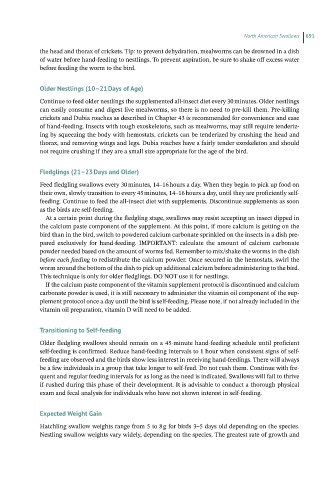Page 690 - Hand rearing birds second
P. 690
North American Swallows 691
the head and thorax of crickets. Tip: to prevent dehydration, mealworms can be drowned in a dish
of water before hand‐feeding to nestlings. To prevent aspiration, be sure to shake off excess water
before feeding the worm to the bird.
OlderNestlings(10–21Daysof Age)
Continue to feed older nestlings the supplemented all‐insect diet every 30 minutes. Older nestlings
can easily consume and digest live mealworms, so there is no need to pre‐kill them. Pre‐killing
crickets and Dubia roaches as described in Chapter 43 is recommended for convenience and ease
of hand‐feeding. Insects with tough exoskeletons, such as mealworms, may still require tenderiz-
ing by squeezing the body with hemostats, crickets can be tenderized by crushing the head and
thorax, and removing wings and legs. Dubia roaches have a fairly tender exoskeleton and should
not require crushing if they are a small size appropriate for the age of the bird.
Fledglings(21–23Daysand Older)
Feed fledgling swallows every 30 minutes, 14–16 hours a day. When they begin to pick up food on
their own, slowly transition to every 45 minutes, 14–16 hours a day, until they are proficiently self‐
feeding. Continue to feed the all‐insect diet with supplements. Discontinue supplements as soon
as the birds are self‐feeding.
At a certain point during the fledgling stage, swallows may resist accepting an insect dipped in
the calcium paste component of the supplement. At this point, if more calcium is getting on the
bird than in the bird, switch to powdered calcium carbonate sprinkled on the insects in a dish pre-
pared exclusively for hand‐feeding. IMPORTANT: calculate the amount of calcium carbonate
powder needed based on the amount of worms fed. Remember to mix/shake the worms in the dish
before each feeding to redistribute the calcium powder. Once secured in the hemostats, swirl the
worm around the bottom of the dish to pick up additional calcium before administering to the bird.
This technique is only for older fledglings. DO NOT use it for nestlings.
If the calcium paste component of the vitamin supplement protocol is discontinued and calcium
carbonate powder is used, it is still necessary to administer the vitamin oil component of the sup-
plement protocol once a day until the bird is self‐feeding. Please note, if not already included in the
vitamin oil preparation, vitamin D will need to be added.
Transitioningto Self-feeding
Older fledgling swallows should remain on a 45‐minute hand‐feeding schedule until proficient
self‐feeding is confirmed. Reduce hand‐feeding intervals to 1 hour when consistent signs of self‐
feeding are observed and the birds show less interest in receiving hand‐feedings. There will always
be a few individuals in a group that take longer to self‐feed. Do not rush them. Continue with fre-
quent and regular feeding intervals for as long as the need is indicated. Swallows will fail to thrive
if rushed during this phase of their development. It is advisable to conduct a thorough physical
exam and fecal analysis for individuals who have not shown interest in self‐feeding.
ExpectedWeightGain
Hatchling swallow weights range from 5 to 8 g for birds 3–5 days old depending on the species.
Nestling swallow weights vary widely, depending on the species. The greatest rate of growth and

